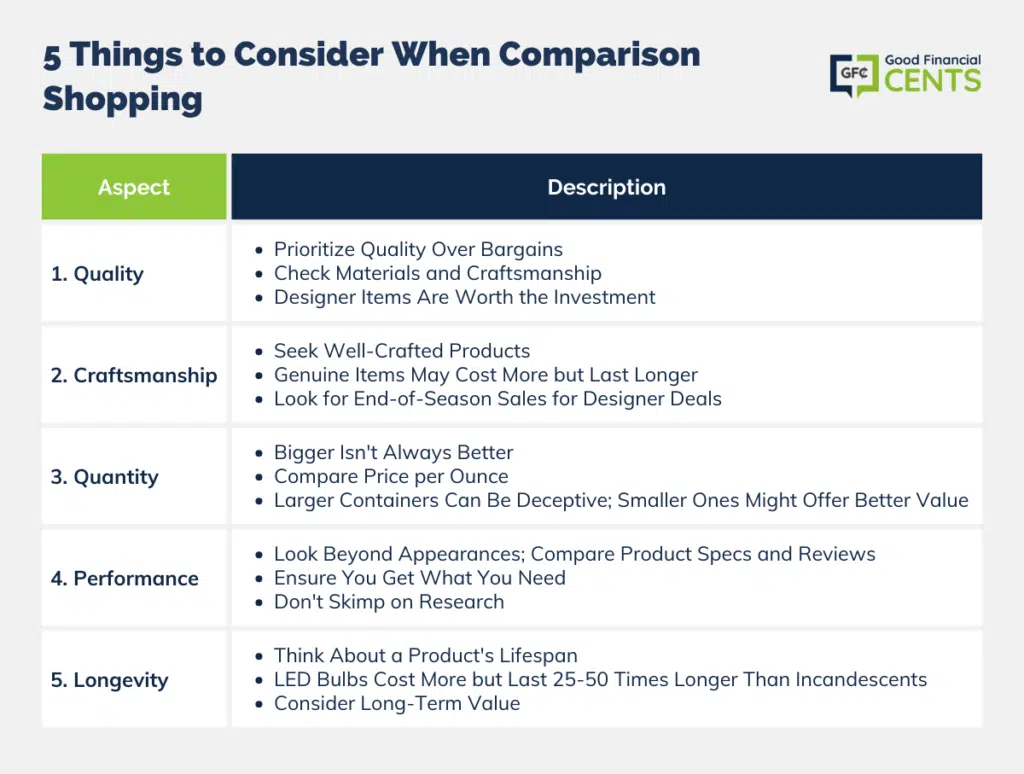One of the wonderful things about the internet is that it allows consumers to shop conveniently from home while comparing products side by side. The problem is, when looking for the best deal we often make the mistake of focusing on the price of an item.
There is more to getting the best deal than getting the best price, whether shopping online or at a local retailer.
Here are five things to consider when comparison shopping so that you never need to wonder if you are getting the best deal.
Table of Contents
Quality
Probably the worst mistake that can be made is to overlook quality when looking for a bargain. There are genuinely good bargains out there on quality items; it just might take a little longer to find them.
Sure, it’s nice to be able to sit down with a cup of coffee and browse the net while looking for the best deal, but don’t forget to think about the materials that a product is made from and who the manufacturer/designer is.
Remember the old saying, “You can’t make a silk purse out of a sow’s ear,” which brings us to craftsmanship.
Craftsmanship
The second thing to consider when looking for the best deal is how and where the product was made. Something that appears to have gone by the wayside these days is good old-fashioned craftsmanship.
You won’t find a genuine Swiss watch or a Coach bag for $29.95 and there’s a reason for that – craftsmanship!
There are knock-offs on every corner, but the real thing always costs more, and in the end, winds up being the best deal.
Quantity
Here is another ‘trick’ that manufacturers often use to fool consumers into thinking they are getting the best deal, and used across the board in everything from electronics to groceries.
If you are curious about how this works, check out coffee creamer the next time you go to the grocery store. It is common to find those huge containers that look to be double the size, and perhaps go for just less than double the price.
But if you were to compare ounce per ounce, it’s readily apparent that the better deal is to buy two of the smaller-sized containers.
There really is double the product at double the price; however, in those misleading huge containers, you pay almost double the price for 1.5 times the amount of creamer.
Are you really getting the best deal when buying a bigger package – usually not!
Performance
Two products may appear to be the same, but quite often one has far superior performance than the other. While there may be no way to judge when shopping in a local retail store, online shoppers have the advantage of reading customer testimonials or reviews.
Product specs are also listed both on the manufacturer’s website as well as on the site of the online vendor or affiliate. Take the time to research how the product works, what is supposed to do, and what others are saying about it.
For instance, two flat-screen TVs may look the same and even be manufactured by the same company, yet one sells for $100 less. It just could be that the backlighting is inferior in one which would degrade the quality of the picture.
Always read the product reviews!
Longevity
And finally, take the time to consider the life expectancy of a product. The next time you go bargain hunting remember to ask yourself this question, “What do vacuum-packed frozen foods have in common with LED light bulbs?”
The answer is quite simple – longevity!
An LED light bulb might cost ten times more than an incandescent bulb, but it lasts between twenty-five to fifty times longer! The life expectancy of an incandescent bulb is 2,000 hours of usage whereas an LED lamp will last from 50,000 to 100,000 hours before dimming.
HINT:
Are you really getting the best deal? It may sound cliché, but the reality is, most often you get what you pay for!

The Bottom Line – Are You Getting the Best Deal? 5 Things to Consider When Comparison Shopping
In the age of online shopping and comparison sites, finding the best deal extends beyond the price tag. Quality, craftsmanship, quantity, performance, and longevity all play crucial roles in determining the true value of a purchase.
Bargain hunters should remember that quality often justifies a higher price and well-crafted items can last for years, ultimately saving money in the long run.
Be cautious of deceptive marketing tactics, such as oversized packaging, and always consider a product’s performance and expected lifespan. Wise shoppers prioritize value over price, ensuring they get what they pay for.
This guest post is by Helen Fang, freelance writer, and avid deal hunter for Dealio. Helen’s favorite day to shop is OpenSky. Helen is not affiliated with or endorsed by LPL Financial.







